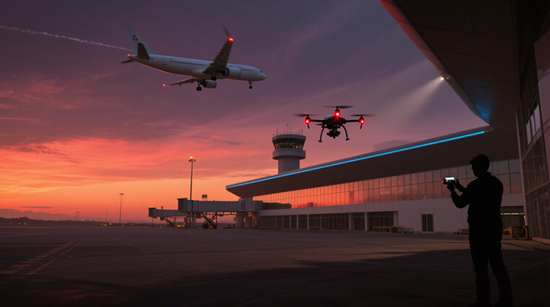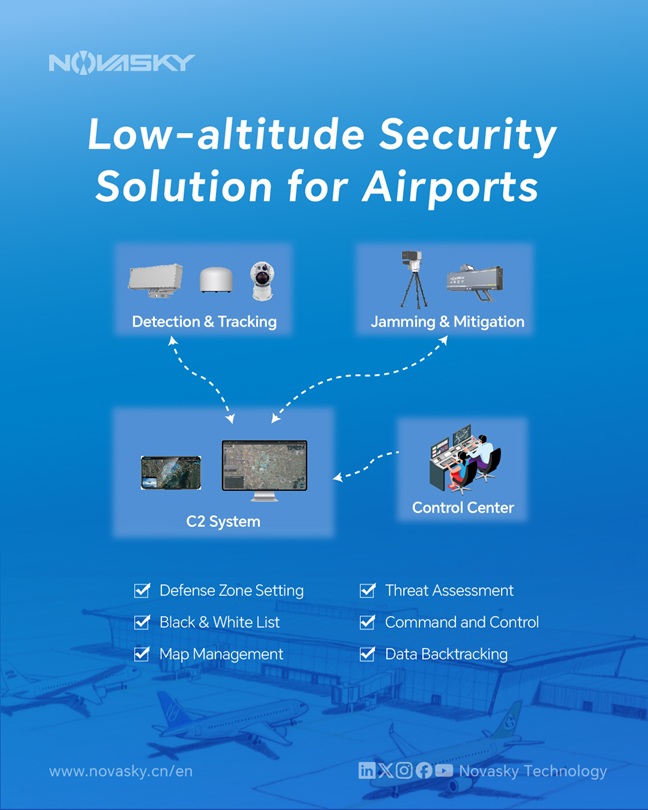In recent years, the rapid development and proliferation of drone technology have brought unprecedented convenience to our lives, while simultaneously posing significant challenges to airport safety. Once these "aerial photography tools" mistakenly enter the airport airspace, can become dangerous "uninvited guests" threatening aviation safety.

01. Why Are Drones a Serious Threat to Airports?
In 2018, Gatwick Airport (UK) was shut down for 36 hours due to drone incursions, leading to the cancellation or delay of hundreds of flights, disruption for tens of thousands of passengers, and massive economic losses.
Airports are busy hubs for aircraft takeoffs, landings, and passenger traffic, demanding extremely strict airspace security. However, unauthorized drone incursions can lead to severe consequences.
Collision Risk: A drone colliding with a high-speed aircraft can damage engines, wings, or fuselage, potentially causing catastrophic accidents.
Navigation and Communication Jamming: Drones equipped with radio transmitters can interfere with airport radar, navigation systems, or communications between aircraft and the control tower, jeopardizing pilot judgment and control.
Security Threats: Malicious actors could use drones for reconnaissance, smuggling contraband, or even terrorist attacks, posing a direct threat to airport infrastructure and passenger safety.
02. How to Catch & Counter These "Intruders"?Demystifying Anti-Drone Technology
Facing these challenges, airports worldwide are actively exploring and deploying various Counter-Unmanned Aircraft Systems (C-UAS) technologies to rapidly detect and effectively neutralize unauthorized drones within their airspace. These technologies fall into two main categories: Detection and Countermeasure.
Precision Detection: Identifying the Threat Instantly
Radar Detection: Specifically designed for small, low-altitude drones. These systems emit electromagnetic waves and analyze the returning echoes to determine a drone's position, speed, and flight path.
Radio Frequency (RF) Detection: Drones emit control and video transmission signals during flight. RF detection systems capture and analyze these signals to identify the drone model, direction, position, altitude, and potentially the operator's location.
Electro-Optical/Infrared (EO/IR) Tracking: High-definition cameras and thermal imaging sensors provide real-time surveillance of suspect airspace day and night, enabling visual identification and precise tracking upon detection.
Acoustic Detection: Identifies the unique acoustic signature of drone propellers, particularly effective for close-range and low-altitude environments.
Effective Countermeasure: Neutralizing the Drone Threat
Once detected, the next step is safely and effectively "removing" or "capturing" the drone. Primary countermeasure techniques include:
Signal Jamming: Radio jamming is one of the most common countermeasures. The device transmits strong electromagnetic waves of a specific frequency to interfere with the control link or GPS signal of the drone, forcing it to land, return to its operator, or hover in place. This method typically avoids physical damage to the drone.
Kinetic Interception: For specific scenarios, methods like deploying "drone capture nets" can be used to physically capture or intercept the target drone mid-air.
Laser Countermeasures (rare in civilian airports): High-energy lasers can theoretically destroy drones. However, due to safety and regulatory constraints, their use is extremely limited in civilian airport environments.
03. Integrated Solutions: A Complete System for Airport Low-altitude Security
A single countermeasure technique is often insufficient against complex drone threats. Modern airports therefore adopt Integrated Counter-Drone Solutions, combining multiple detection and mitigation technologies within a single intelligent platform.

Novasky's Integrated Low-altitude Security Solution for Airports
Novasky's solution integrates cutting-edge technologies to provide comprehensive protection for airport airspace. The system comprises four core subsystems: Detection, Countermeasure, Command & Control (C2) and Communications.
Detection Subsystem: Combines Low-Altitude Surveillance Radar, TDOA (Time Difference of Arrival) RF Detection, and EO/IR Tracking. Radar detects and locates drones; RF detection finds direction and analyzes drone signals; EO/IR provides visual confirmation and continuous tracking.
Countermeasure Subsystem: Utilizes Directional Jammers and Handheld Counter-Drone Detection & Jammer Guns to disrupt rogue drone signals and provide targeted countermeasures.
Command & Control (C2) Subsystem: Features a centralized C2 Management Platform typically located in the airport control room. Internal communication uses wired networks.
Novasky's low-altitude defense system provides interfaces for integration with existing airport security systems, creating a unified management platform for centralized monitoring, display, and coordinated command. The platform also supports connectivity with Regional Drone Management Cloud Platforms and airport monitoring systems, enabling emergency response coordination.



 Low-Altitude security(Anti-drone)
Low-Altitude security(Anti-drone)

 Life Detection & Search
Life Detection & Search

 Through-wall Detection
Through-wall Detection

 Access Control
Access Control

 Perimeter Security
Perimeter Security


